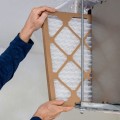When it comes to air filter oil, it's best to let it dry for at least 24 hours before using it. This will ensure that there isn't too much oil and that the air filter is not damaged. If you're in a rush, however, you can let it dry for two hours in a well-ventilated room. Disposable air filters for cars are usually made of paper and are very effective at trapping dust.
However, they can also restrict air flow. To clean the air filter, you'll need a vacuum cleaner, a hose attachment, a new air filter, a screwdriver and new screws. Internal testing of an overgreased K&N air filter under extreme airflow conditions and the use of an absolute test filter have confirmed that no oil came out of the K&N replacement air filter. The oversized conical air filters used in K&N's high-performance air intake systems can last up to 100,000 miles before needing to be replaced.
It's important to learn how to clean your own air filter before consulting a professional. Greasing a K&N air filter with the air filter oil spray found in the K&N 99-5000 filter cleaning kit is quite simple and can be done quickly. When using the air filter oil squeezer bottle found in the K&N 99-5050 filter cleaning kit, apply K&N air filter oil evenly along the crown of each fold. Air filters also help keep dirty air out of your engine, increasing its lifespan.
Once the oil in the K&N filter is properly and evenly absorbed through the cotton, no oil will be released, even under extreme engine conditions. To begin cleaning your air filter, first pour water into a bucket and then locate the position of the air cleaner and unscrew it with a screwdriver or any other recommended tool. The amount of time it takes for an air filter to dry depends on its type and the climate. Be sure to follow the recommended drying time and make sure that it is completely dry before using it again.
Air filter oil prevents water, mud, dust and sand from entering your engine by trapping these impurities in the air filter. It's also important to know when to clean your air filter in order to avoid costly engine damage or metal component oxidation.


